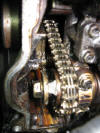
Home | Mailing List | Specifications | Care and Feeding | Modifications | Vendors | Literature

09/18/2009
I recently bought a (cheap) 1997 parts SHO with a failed engine. I planned to
use the transmission (minus the valve body) in my 1999 welded SHO and part out
the rest. However, before I junked the car, I decided to look at the carnage in
the engine. Last night, I took off the front valve cover and did not find what I
was expecting. When the cams fail on these cars, it is usually the secondary
sprockets which slip (right?). Look at the pictures I have attached. I found the
PRIMARY drive sprocket broken into at least 8 pieces(!!) with the timing chain
still appearing to be intact. Also, the secondary sprocket's chain was broken.
The secondary sprockets do not appear to be slipped at my first glance, and I
can't move them.
How often has the primary sprocket failed? Do you think there is another reason
for its failure? I would think it would need a LOT of torque to fail like that.
It looks like the broken chain on the secondary sprockets really dug into the
wall. Does this chain fail very often? If it binds, that could cause a bit
torque spike. The previous owner said it ran fine (and without any noise) until
one day the motor wouldn't budge when she tried to start. I can now see why the
motor didn't want to move!
Any ideas on how easy this would be to fix? This is the first cam failure I have
seen in person. I imagine there are sprocket pieces that have fallen down deeper
to near the crank (ugh!). I really need to also pull off the rear valve cover to
make sure it is ok. I'm trying to evaluate whether I should fix it or just
continue with my original plan. I hate to part out this car at only 115k miles
if I don't need to. The car is in decent shape, but not great either.
Thanks,
Peter





___________________________________________________________________________________
I see some secondary chain wedged beneath the exhaust secondary sprocket. I'm
believing this locked the exhaust cam with a lot of inward radial pressure that
would have forced the sprocket bore tighter against the tube and not let it
break loose. The larger primary diameter transmits a lot of torque and with
those weight lightening holes I guess the strength wasn't enough. Pull those cam
bearing caps and see if that cam rolls out without much difficulty. It would
definitely be neat if the initial point of failure could be identified.
Lucien
ęCopyright 2000 - 2009; all rights reserved by V8SHO